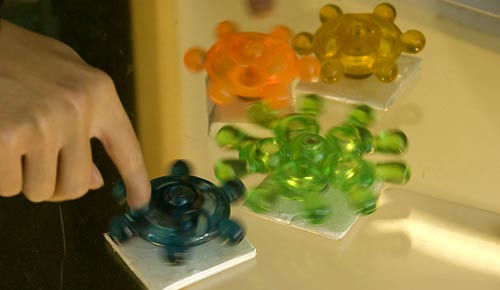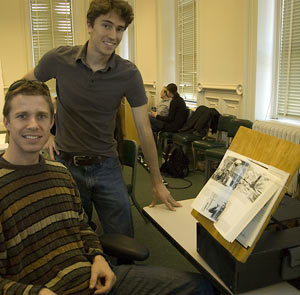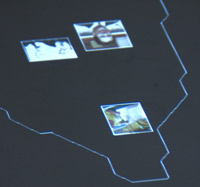 Creating sound with a music generator called "Music
to My Gears." (Melani
King photo)
Creating sound with a music generator called "Music
to My Gears." (Melani
King photo)Student tinkerers test-drive their interactive inventions
 |
| 16 December 2008
 Ryan
Kaufman and Sean Carey test drive their "Ergo Desk." (Melani
King photo)
Ryan
Kaufman and Sean Carey test drive their "Ergo Desk." (Melani
King photo)BERKELEY — Fanciful and improbable devices for doing household tasks earned immortality for cartoonist Rube Goldberg, who graduated from UC Berkeley in 1904. Students at the campus's School of Information (iSchool) channeled Goldberg's spirit last week, debuting a roomful of interactive inventions marrying the physical with the digital.
The two-day open house was the grand finale of "Theory and Practice of Tangible User Interfaces," a.k.a. "TUI," a design studio taught by Assistant Professor Kimiko Ryokai.
"Usually when we use computers, we have computer screen and keyboard and mouse," notes Ryokai. In weekly labs, her students used devices like sensors and activators to take technology beyond that desktop paradigm — inventing interactive devices designed to teach, solve problems, provoke thought, or create fun.
In South Hall — the oldest of all UC buildings, completed in 1873 — students showed off such 21st-century gizmos as "Music to My Gears," a noisy and sometimes melodious contraption using toy gears and a laptop to generate music and teach kids about gear ratios. Another trio of students, in the glow cast by their projector, talked up "PowerFall," an attractive energy-consumption display that, installed in a lobby, would remind apartment dwellers in real time of how much electricity their unit was consuming.
"People want to know how much power they're using," said iSchool student Ljuba Miljkovic. "Our approach is to do it in a way that's aesthetically pleasing and is central to a common shared space."
Some teams chose to update traditional toys and games, like Battleship — once played with graph paper, but now featuring a watery battlefield projected on a screen and a player platform that, when activated by a bed shaker, simulated the feeling of being aboard a ship.
 "Digital
Shadow," a fun TUI project with a serious subject — online
privacy. (Melani
King photo)
"Digital
Shadow," a fun TUI project with a serious subject — online
privacy. (Melani
King photo)Undergrads Ryan Kaufman and Sean Carey rigged up a Goldberg-esque "Ergo Desk," using an office chair and a reading stand that conspire to reinforce good reading posture. When the reader slouches, a pressure sensor in the chair causes the bookstand to fall away, making the text less legible.
The TUI design studio attracts iSchool and computer-science grad students. Others are welcome as well, with the caveat that "you need to have some technical background," recalled Kaufman, a rhetoric major — as his design partner, from interdisciplinary studies, fiddled with some uncooperative wires under the hood of their ergonomic device. With five years of avionics under his belt, Kaufman decided to brave the course, and found it to be a lot of fun. "Basically they give you a new mechanical or electromechanical device every week and say 'make something of it." But, he admitted, "I was a little overwhelmed with the programming."
Professor Ryokai emphasized that as well as tinkering with objects, students in the class should be observing human behavior, reported iSchool master's student Andy Brooks. He and his two collaborators, social scientists all, took that advice to heart — spending time at the Free Speech Movement Café "observing how people actually use the space," he said. From those caffeinated sessions was born "The Reflectable," a table top that "captures" and remembers how café denizens have arranged their objects on its surface, redisplaying each person's pattern in brightly colored geometrical shapes whenever he or she returns. Human beings like to leave a personal mark on public spaces, observed Brooks. "The Reflectable" lets them do that "without physically defacing" the commons.
In the past, added grad student Erin Knight, "I was never in the mindset of inventing something new." But her work in the TUI lab changed her outlook. "Literally building things, soldering circuits, getting down to the nitty gritty — it forces you to start to look at the world a little different. You start to think that if you could build anything, what would you build?"

